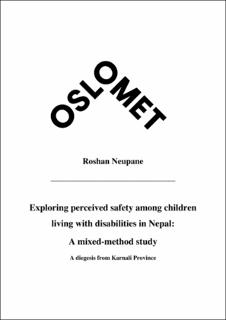| dc.description.abstract | Defining disability is complicated as it is complex, dynamic, multidimensional, and contested. The purpose of this mixed-method study was to explore the perceived safety of children living with disabilities, reasons behind unsafety, and to explore possible measures to create a safer environment for the children with disabilities residing in Karnali Province, Nepal. This research identifies the factors associated with perceived safety, the reasons for being unsafe, and some possible ways forward to create a safe living environment.
This mixed-method study applies qualitative and quantitative approaches. In the qualitative research, 18 respondents with and without disabilities working in various sectors of disability were interviewed. In-depth through interviews were conducted through the phone using self-developed interview guidelines in Karnali Province, Nepal. Thematic analysis was done for qualitative data analysis. Statistical tests (chi-square, binary logistic regression, T-test, ANOVA Test, and stepwise logistic regression) were carried out for 1089 quantitative data collected by Save the Children. Ethical approval was obtained from Nepal Health Research Council, Nepal and guidance were sought from Nepal Norwegian Center for Research Data, Norway.
Bronfenbrenner's Ecological Systems Theory was used to understand child development in context and different levels of living environment. Furthermore, Critical disability theory was also used to understand the disability through a holistic approach.
Children feel less safe in the community than in the school setting. This is the study's central finding. Children with disabilities experience almost 20 per cent less safety in school and 10 per cent less safety at the community level compared to children without disabilities. It was assessed that girl feels less safety even within the disability group at school and in their community. On the other side, the qualitative study raised the concerns of awareness, effective implementation of policies, need identification and granting support to the targeted population and comprehensive approach for the intervention of safe and disabled-friendly environment.
Grass-root level interventions were found urgent to enrich the quality of living in society for children with and without disabilities. That is why evidence-based preventive, comprehensive, and holistic intervention based on child safety and disability is recommended by this study for providing a better quality of life and a healthy environment for our children. | en_US |
